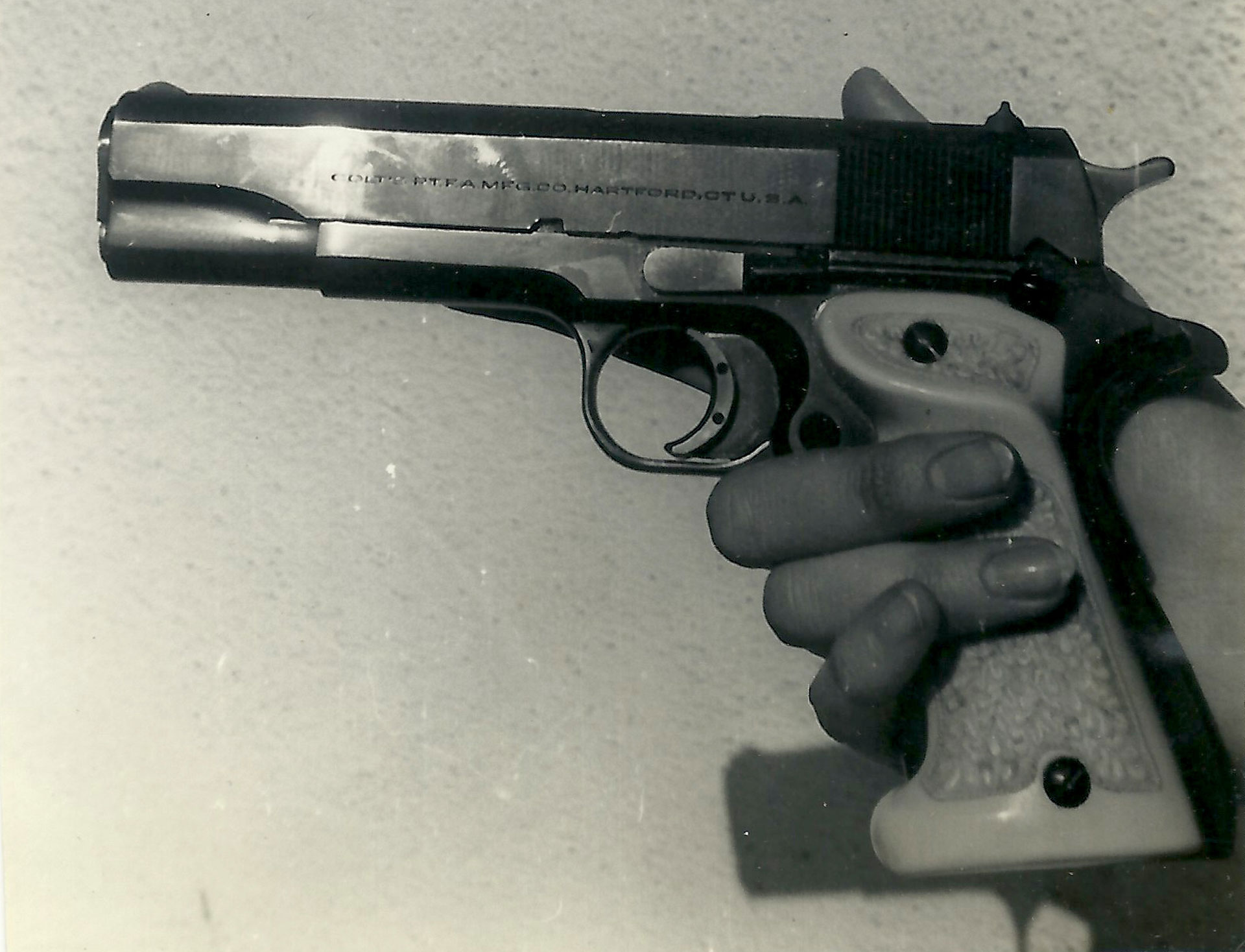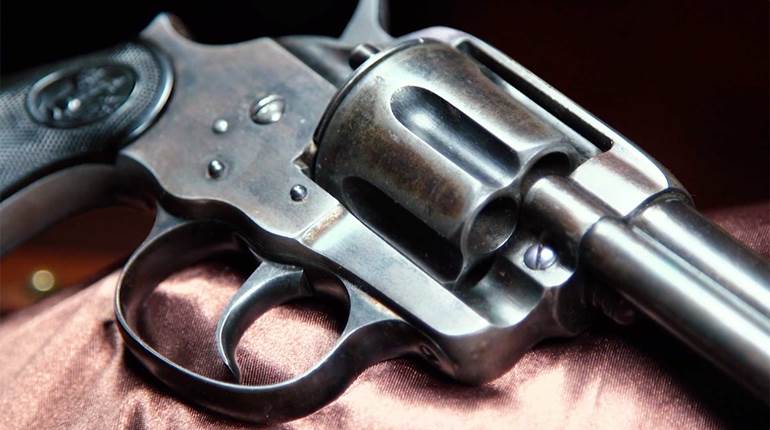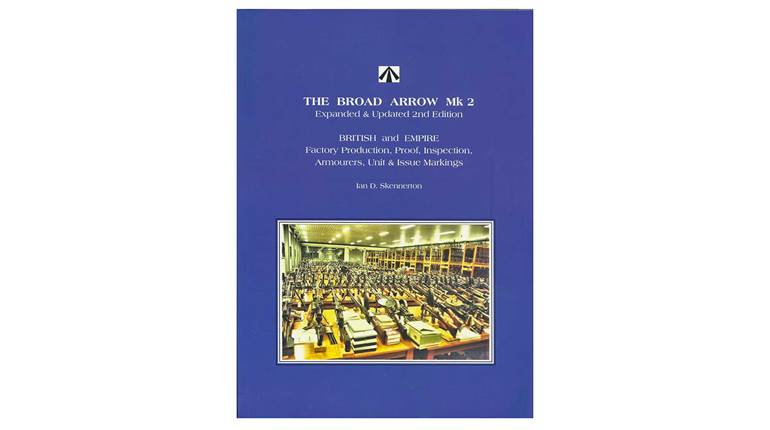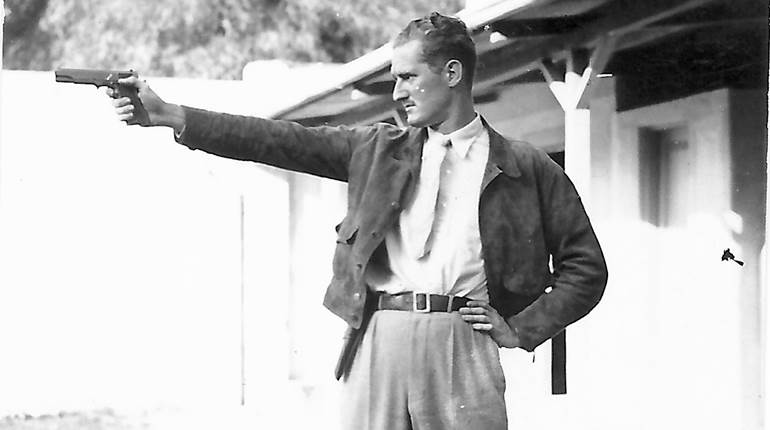
Deadly with a pistol, compulsive adventurer Donald Bateman Hope Coates was a storyteller who kept his fellow gun enthusiasts, as well as listeners from all walks of life—and from all over the world—enthralled by his many tales. In my previous article about Coates, I was unable to pin down some of the stories that he had told to my sources, and I had to connect a lot of dots—as best as I could—in order to write a bare-bones biography of him. Indeed, some readers and researchers were skeptical about Coates’ stories.
Even my main source, and dear family friend of the Coateses, Deborah Jann, told me that she had a hard time believing a story that he had told her about sitting with Errol Flynn and Ernest Hemingway—all three of them nursing hangovers—on a Mexican beach shortly after World War II. (As it later turned out, according to a 1946 article in the Chicago Tribune, I found that Flynn was making a movie in Mexico about a “Frank Buck-like” wildlife adventure, for which Hemingway had written the script, and it involved a lot of flying over the jungle—but the film was never completed. So, with corroborating pictures from Coates’ family photo albums of Donald on stage with monkeys and other jungle creatures in a 1940s-era Los Angeles film studio, this tale did check out!)

Sadly, Deborah Jann passed away in October 2021, and her husband, Ted, found some of Donald’s effects among her belongings, which he very kindly passed on to me. In addition to the crude, homemade Irish blackthorn shillelagh that Donald treasured as a souvenir of his days in Ireland during the “Troubles,” Ted gave two of Donald’s British passports to me. Regrettably, Donald’s passport from the 1920s was not in the group, but the immigration and customs stamps in the two surviving passports showed that Donald was a “commercial air pilot” in Cuba in 1934, and that he had traveled extensively in Mexico and in Central and South America.
Most importantly, he also traveled from Britain to “Sweden” (as was customary for those volunteers fighting for the Finns in the Russo-Finnish “Winter War” of 1939-1940 to have stamped in their passports) in 1939. In addition, I was able to confirm that he had also traveled to Canada, crossing the border at Niagara in 1943, where he taught Canadian aviation cadets in Newfoundland how to fly, like he had told his third wife, Ashley, that he had done.

Along with the passports, I found another fascinating piece of Donald Coates’ memorabilia in the group. It was an apparently unpublished yellowing typescript of a short story that he had written in the 1950s about a .45 Colt semi-automatic pistol. Entitled "Ivory Grips," the story is reminiscent of the pulp fiction articles that graced the pages of the “Men’s” magazines of the 1950s and early 1960s that were avidly read by teenagers at Pennsylvania deer hunting camps in those days—this author included! The tale may bring back some fond memories for fellows who like a good yarn about guns and derring-do. “Ivory Grips” goes like this:
I had arrived the day before in La Ceiba on a fruit boat, and was having a drink with the American Vice Consul in the bar of the Hotel Royal, when I first saw Dick Maitland.
I noticed him as he walked past us to the bar. He had greeted my friend with a cheery smile as he passed, and there was something in his manner and looks that prompted me to ask who he was.
"That’s Dick Maitland,” replied my friend, “and he’s quite a character, I can assure you. He has been, and done everything there is to do. Started off at quite an early age during the Troubles in Ireland but which side he was on, I’m not quite sure! Anyway, he tells some amusing and exciting yarns about those times. There was a price on his head, I understand, but the money would be rather hard to collect I imagine, as he is one of the fastest gun slingers I have ever run into.”
I looked across the room to where Maitland was standing at the bar with a Planter’s Punch in his hand, talking to the Paraguayan bartender, Pedro. He was quite an impressive figure— I had to admit. Tall and lean, about 6' 3" I guessed, and one of those Englishmen of indeterminable age that one runs across not too infrequently in the tropics.
Dressed like all of the other banana herders at the bar, in khaki shirt and pants, with the exception of his shoes and hat, the former being crêpe-soled desert boots of rough reversed hide, usually referred to by the RAF types as “Brothel Creepers, his hat was a well worn version of the safari hat, complete with leopard skin band, so dear to all African big game hunters. His face was tanned, and deeply lined in crow’s feet around the eyes, or should I say eye, as a black patch covered his left eye, and gave him rather a “piratanical” appearance.
“He was a tea planter in Ceylon," my friend went on, “and a rubber planter in Malaya, and later a white hunter in East Africa, although ‘ivory poacher’ I’ve since heard was a better term. Anyway, how’d you like to meet him? He’s lots of fun, and has one of the loveliest women as a wife you ever saw, half-Russian and half-Scottish. Boy, I’ll tell you she’s really something!” I said that, even without the added inducement of a lovely wife, I would very much like to meet Maitland.
“Dick, come over here and have a drink with us,” he called, “I have a friend I want to you meet!”
After greetings had been exchanged and another round of drinks ordered, I noticed for the first time that Maitland was wearing a .45 Colt automatic in a well-worn cross-draw holster, on the left side of his heavy leather belt.
“That’s a nice gun you’ve got there!” I said at last, our introductions over. “I’m quite a gun nut myself, and unless I’m much mistaken, that’s a pre-war National Match?”

The holster, little more than a loop of heavy leather on his belt, showed me that the gun, although well-worn, was well cared for, and it’s ivory grips were yellow with age and sun.
“Yes, you’re quite right.” Maitland replied, “its an old timer and has seen a lot of service. I got it in ’39 as a farewell present to a friend who was going back to the war. He was carrying this same gun when he was dropped behind the lines in France in ’43, to help organize the Maquis in their resistance movement. The Nazis got him and tortured him to death, poor devil. Except for a new Match barrel, the gun is as I gave it to him, and his initials are cut inside one of the ivory grips.”
“I don’t think I get you,” I ventured, “if your friend was carrying the gun when he jumped over enemy territory, and was presumably carrying it when he was taken by the Nazis, surely they weren’t so kind as to return it with his effects?”
“No,” Maitland laughed, “the Huns were not quite so accommodating as that, I had to get it back the hard way.”
“Let’s hear about it,” the Vice Consul broke in.
“It’s quite a long story, so let’s replenish our sadly failing glasses,” Maitland answered.
A new round of Planter’s Punches ordered, we settled down to hear what promised to be a very interesting tale.
“Around ’46 in Mexico City, I became acquainted with a very attractive girl,” began Maitland, “and the estranged wife of a German named von Betz. It seemed she married him in ’39 when she was a kid of 18. She was either American or English, and when the war started at the end of ’39, he became so unbearable with his Nazi propaganda, that they separated— she staying in Mexico, and he going to Bogota, Columbia, to work for an Italian firm."
“I went 'round with her quite a bit, and one day what should I see on the night table in her apartment but this very gun! There was no mistaking the fact that it was the same gun, and I asked her to let me remove the left grip, and there, sure enough, were the initials C. D. S. cut in the ivory. She told me it was her husband’s gun and that he had left it there a few months before. A week or two later, I asked her if she would part with it, as it was of great sentimental value to me. She told me she no longer had it, as her husband had arrived suddenly one day, telling her he had a new job on a coffee finca in Chiapas in the south of Mexico, and needed the gun, so he had taken it with him.”
Maitland paused to take a drink and then went on, “I made some inquiries with connections I have in Bogota, and found there had been a von Betz there until 1941, but he had later gone back to Germany and had become quite a big shot in the SS."
“I rechecked again with some friends of mine in Mexico City, who were able to “persuade” some former Nazi boys to give them a list of the more active members of the SS that had tried to break the French resistance movement. Our friend von Betz was very much to the fore, it was found."
“My business took me to Chiapas in the course of the next few days,” Maitland said, smiling. “Purely chance, I assure you! In Tapachula, the principal coffee town in Chiapas, I made my first mistake. Tapachula has quite a few German residents, or at least many German coffee planters from the neighboring coffee fincas visit there. So here I was looking for a German I had never seen in real life, with nothing but a couple of faded snapshots to help me. I asked the cantinero of the most popular cantina in town, if he knew anyone by the name of von Betz."
"He gave me a rather surprised look and said, "No, senõr, but I will make inquiries for you." He talked to two men sitting at a table in the corner of the room, and presently returned with the information that one of his friends knew von Betz but that he, von Betz, had flown the day before to Tenosique. As luck would have it the next day, I got a ride with an old ‘chiclero’ pilot friend of mine, who was going to Villa Hermosa, and agreed to drop me off at Tenosique. When I got to the town, I found that von Betz had preceded me by only a few hours. I was told he had taken a cayuca up the Usumacinta River and was headed for the Lacandon country, but if I hurried on mule back along the river’s edge, I might catch him within a few miles."

“I set off at once, on one of the only riding animals to be had, a flea-bitten old mule, but as sure-footed as a cat. (Give me a mule in preference to a horse anytime in that sort of jungle country,” Maitland added.)
“Well, to cut a long story short, I really walked into it,” Maitland gave a low chuckle. “Rounding one of the huge boulders that lined the bank of the river, I was greeted with a terse command to dismount. There, 20 feet away, sitting with his back to a rock, his two arms supported by his knees, was a big blond brute of a man covering me with this .45 ACP. ‘Manos arriba, English pig’, he called to me the moment I dismounted. I was carrying a .45 Colt New Service with a 4.5" barrel, in a Tom Threepersons holster, and I squeezed off a couple of quick shots from the hip as I hit the dirt. Something seemed to explode in my face as I went down, and I felt as if I had been hit on the left side of my head with a sledgehammer. I must have been half-stunned, because I lay where I was for a moment, instead if rolling over, and shooting the second I reached the ground.
“When at last my senses cleared—which seemed hours later, but in actual fact could only have been a matter of seconds, I saw von Betz was slumped forward on his face, and not moving. I climbed to my feet and staggered towards him. I pulled him over on his back and saw that one of my shots, the first, presumably, had taken him in the breastbone, and the other in the groin. He was quite dead! By now, I was more than aware of my own injuries. Blood was running down the left side of my face, and my left eye—which I could not see out of—was starting to hurt like hell. I then realized what had happened."
"Von Betz’s shot had hit the rock just beside my head and stone, and perhaps metal, had been driven into my left eye.” Maitland finished his drink in one gulp and lit a cigarette. “I dragged von Betz to the river and shoved his body in. The Usumacinta is full of crocs, so I knew they would take care of him. I felt that a swine like von Betz hardly deserved a Christian burial anyway. I had a hell of a job getting back to Tenosique. I was half-blind, and it got dark quickly, as it does in the tropics. I also had a job catching the mule, which seemed to have an aversion to fireworks."
The local commandante seemed to believe my tale about being shot at by some enthusiastic bandit, and my inability to catch up with my friend through this unforeseen delay. I lost my left eye, but I settled an old score and got this gun back.” Maitland smiled grimly to himself as he spoke. “However, I though that a change of scenery might not be too amiss. You can’t always trust those damned crocs,” he laughed.
Our conversation was interrupted at this point, by the appearance of a tall and striking looking blonde, headed for our table. I barely had time to take in the exquisite legs and figure before I found myself presented to one of the loveliest, and most charming, women I have ever had the pleasure to meet.
“This is my wife, Ann.” Maitland said to me, as I took the long slim hand proffered to me.
After another round of drinks and some generalities had been passed about Honduras and Central America, Maitland and his charming wife left us, bound for the club where they had a luncheon date.
I remarked to my friend that the Maitlands made one of the most interesting couples I had met in a long time.
“She’s really gorgeous, isn’t she?” he asked, a dreamy look in his eyes. “Used to be a Mrs. von Betz, the British Vice Consul tells me, but perhaps von Betz is a very common German name. Really, I don’t know, I’m sure.”

As thrilling and interesting as this tale is, it was not the most important piece of paper in the small pile of yellowed documents that Ted had given to me. Hidden among the other pages was a typewritten list of Donald’s guns that his wife had given to a close friend of his to sell for her in 1995. Presumably, these guns were then sold in the Northern Virginia area (Donald had already sold several of his guns when the Coateses moved from California to Virginia in the 1960s) and one of these firearms may be in your gun safe. They are:
Smith & Wesson Model 60 Revolver (Blue) 2” .38 Spl. S/N 216518
Ruger Speed Six Revolver (Blue) 3” .357 Mag. S/N 16199631
Colt Mk V Trooper Revolver (Blue) 4” .357 Mag. S/N 41614Y
Ruger Redhawk Revolver (Stainless Steel) 5.5” .44 Mag. S/N 500-94050
Ruger Redhawk Revolver (Stainless Steel) 7.5” .44 Mag. S/N 500-13671
Ruger Redhawk Revolver (Stainless Steel) 7.5” .44 Mag. S/N 500-09403
Smith & Wesson Double Action Automatic (Stainless Steel) 5” .45 ACP S/N TAY0265
Colt Model 90 Double Action Automatic (Stainless Steel) 5” .45 ACP S/N DA75537
Colt Government Model Auto (Blue) 5" .45 ACP S/N C223805
Colt National Match Automatic (Parkerized) 5" .45 ACP S/N 858811
Colt Model 70 Automatic (Blue) 5" .45 ACP S/N 46074B70
Colt Model 80 Automatic (Blue) 5" .45 ACP S/N FG32958
If you have one of these guns in your arms storage safe, then you own a handgun that has an association with a larger-than-life Pistolero, a legendary adventurer, and, as one of his friends described him—“The Real Deal.”





































